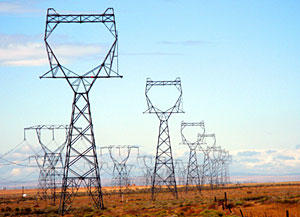
The first 10 miles of the McNary - John Day Transmission Line, Highway 14, Washington.
A new White House policy document released today* highlights strategic roles that the National Institute of Standards and Technology (NIST) plays in accelerating the modernization of the nation's electric infrastructure, bolstering electric-grid innovation and advancing a clean energy economy, in part by advancing "smart grid" technologies. The White House unveiled the document today at its "Building the 21st Century Grid" event, which brought together many cabinet departments and agencies working together toward these goals.
The document, "A Policy Framework for the 21st Century Grid," was issued by the National Science and Technology Council (NSTC), administered by the White House's Office of Science and Technology Policy. It provides a roadmap for making investments in the nation's electric infrastructure in ways that benefit all Americans. Planned changes to the grid include its evolution into a far more modern system, integrating renewable sources of electricity, accommodating the growing number of electric vehicles, and helping to avoid blackouts and restore power more quickly when outages occur. To make these improvements, the strategy rests on four pillars, including one in which NIST plays a leading role: a focus on standards and interoperability to enable greater innovation in modernizing the grid.
Because updating the grid will require a host of interoperability standards to ensure its millions of devices and systems can operate effectively with one another, NIST has been working to bring various industry groups together to coordinate the development of these standards—an effort the White House highlights in the report.
"This document is the culmination of nine months of work by the NSTC subcommittee on Smart Grid to develop an administration policy framework for modernization," said George Arnold, the National Coordinator for Smart Grid Interoperability at NIST. "It highlights the importance of standards to ensure that innovation can be introduced into the grid without stranding previous investments. NIST has played a major role in the modernization effort along with the Department of Energy."
The event also served to highlight opportunities for innovation in the nation's electric infrastructure and to announce a number of new initiatives for achieving a clean energy economy, including NIST's work with the Asia-Pacific Economic Cooperation (APEC). NIST, together with the U.S. Trade Representative, has launched a collaborative initiative in APEC on Smart Grid interoperability standards, crucial to increasing market opportunities throughout the region, including for American firms.
"APEC's 21 countries are concerned with facilitating economic cooperation in the Asia-Pacific region, and each year they pick a key topic to advance regulatory cooperation to facilitate trade," Arnold said. "This year APEC elected to focus on Smart Grid because all these countries are modernizing their grids. These standards can either be a barrier to trade or facilitate it. If we can achieve a commonality of standards, manufacturers can build equipment and then sell it across the region."
For more information on the Grid Modernization Event and the report, visit the White House's fact sheet.

